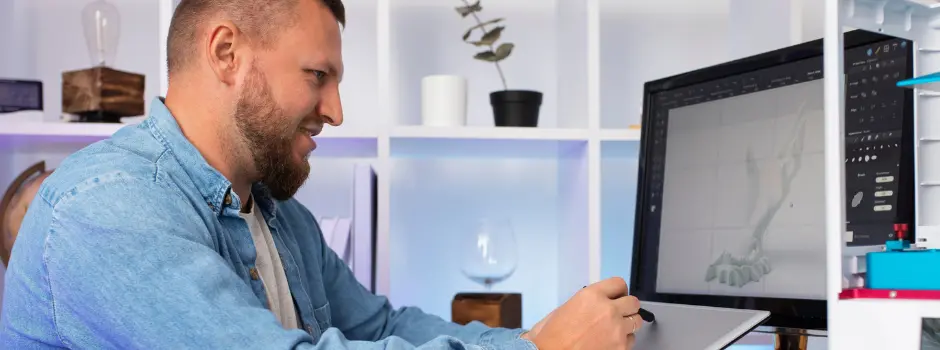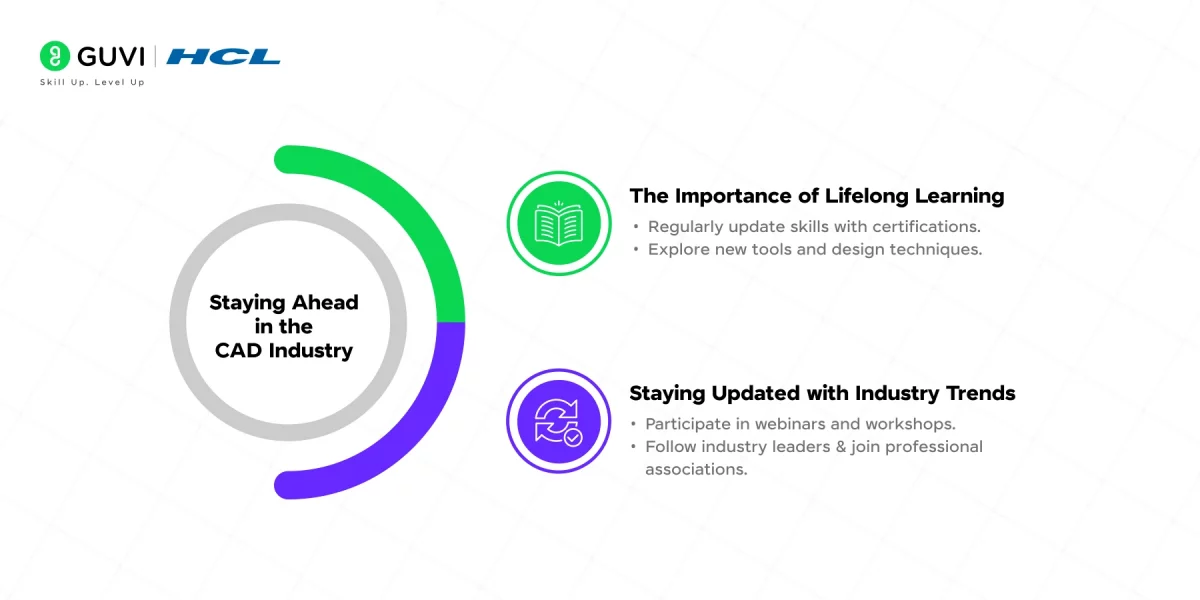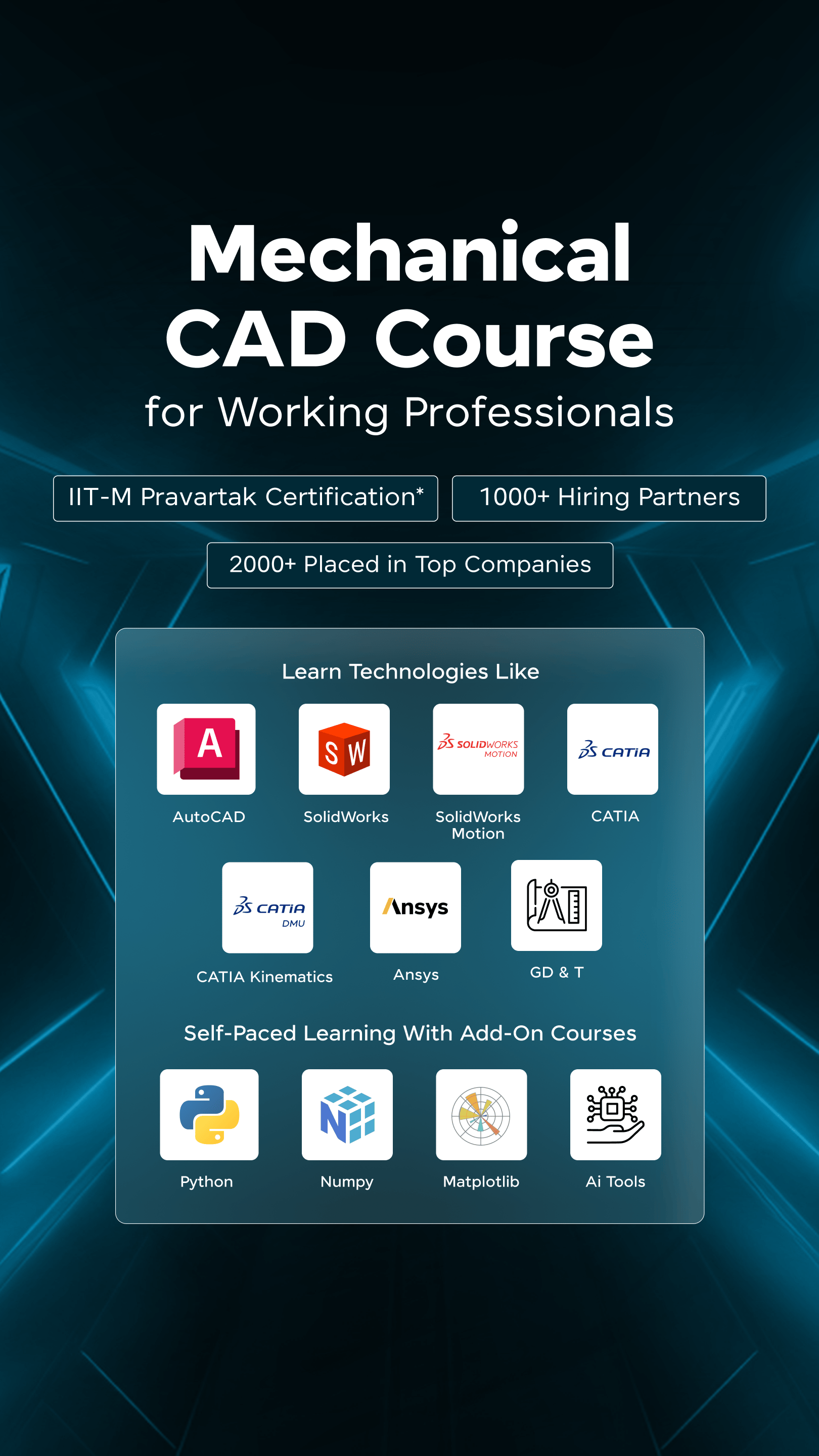
How to Become a CAD Designer in India: The 4-Step Process
Feb 07, 2025 4 Min Read 1442 Views
(Last Updated)
CAD design, or computer-aided design, has shaped industries since the 1980s. Back then, it changed how engineers and designers approached their work. Fast forward to the present, CAD design has become highly integral. The advancements in cloud computing, artificial intelligence, and AR/VR have increased the demand for collaborative and efficient design solutions.
So, what is CAD design? It requires specialized software to create detailed drawings, models, and blueprints for various projects. These can vary from designing cars and buildings to complex machinery and electronics.
At its core, CAD design bridges creativity with precision, enabling industries to turn their ideas into reality faster and more effectively. If you’re curious about how to become a CAD designer in India, this guide will walk you through the essential skills and steps required for this rewarding career.
Table of contents
- Who are CAD designers, and what do they do?
- The key responsibilities of a CAD designer include:
- How to Become a CAD Designer: 4-Step Process
- 1) Meet the basic requirements
- 2) Learn CAD software
- 3) Gain experience
- 4) Develop soft skills
- Why choose GUVI to fast-track your career as a CAD designer?
- Wrapping up
- Frequently Asked Questions
- What qualifications do I need to become a CAD designer?
- Which software is essential for CAD designers?
- Can I become a CAD designer without a degree?
- What industries hire CAD designers?
- How long does it take to become a CAD designer?
- What skills are most important for CAD designers?
- How do I gain experience as a CAD designer?
- Why should I pursue a CAD course from GUVI?
Who are CAD designers, and what do they do?
CAD designers are professionals who render concepts into detailed digital blueprints and models. Their role is recognized in the engineering, architecture, automotive, manufacturing, and entertainment industries.
CAD designers are the ones who put together all the moving parts, be it creating detailed mechanical parts or designing entire buildings. They ensure every specification is accurate per requirement and ready for implementation.
The key responsibilities of a CAD designer include:
- Teaming with engineers and architects to understand project requirements.
- Creating 2D and 3D designs using specialized software like AutoCAD, SolidWorks, or Revit.
- Ensuring designs meet technical guidelines and industry standards.
- Modifying and updating designs based on feedback or new requirements.
- Preparing documentation, including technical drawings, to guide manufacturing or construction.
The ideal skills and qualifications of a CAD designer include:
- Technical skills: Mastery in CAD software is mandatory. You should be familiar with tools like CATIA, AutoCAD, or SolidWorks, which can open doors to opportunities in various industries.
- Attention to detail: You need to be eagled-eyed. Even the smallest errors in designs can lead to major issues during execution.
- Problem-solving: Unexpected challenges often arise during projects. It’s a great deal for you to be good at problem-solving.
- Education: While a degree in engineering, architecture, or a related field is helpful, you can enter the field and become a CAD designer with specialized certifications or diplomas.
How to Become a CAD Designer: 4-Step Process
For you to become a CAD designer, here’s our 4-step process to guide you through:
1) Meet the basic requirements
- Education: You should have a diploma or bachelor’s degree in mechanical engineering, architecture, or industrial design. These programs familiarize you with important principles like drafting, design, and material science. These are the backbone of CAD design.
- Certifications: You can undergo specialized CAD certifications from reputable platforms like GUVI. You benefit from targeted training in software and techniques. Such certifications enhance your skills and make your resume more credible to employers.
2) Learn CAD software
Mastery of CAD software is essential to becoming a skilled CAD designer. Start with the following:
- AutoCAD: AutoCAD is widely used across industries, be it architecture or mechanical design. It’s best suited for 2D drafting and 3D modeling.
- SolidWorks: SolidWorks is valued for its intuitive interface and specializes in designing mechanical parts and assemblies.
- Revit: Revit is a go-to tool for architects and structural engineers, as it simplifies building modeling and design.
- CATIA: CATIA is frequently used in aerospace and automotive design. It allows ease of handling complex surfaces and assemblies.
3) Gain experience
Practical experience is what turns knowledge into skill. Here are some options for you to get started and test your acquired knowledge (while also getting paid for it!):
- Internships: Engineering firms, architectural studios, and manufacturing companies often list internship opportunities. Starting as an intern is the best way to get hands-on experience with real projects and professional workflows.
- Freelance projects: Platforms like Upwork and Fiverr are still a hub for good opportunities. If you want to get into drafting plans for a renovation or even designing mechanical parts, you can find good design projects to refine your skills and build a portfolio.
- Personal projects: Another option is to create your own projects to experiment with different tools and techniques. For instance, you can design a mechanical part, a building floor plan, or even a consumer product prototype. You should document your process and outcomes to showcase your abilities for bigger opportunities.
- Team-up: You can join open-source CAD projects or team with peers in related fields. Doing this will help you sharpen your skills and learn the art of collaboration and industry-standard practices.
4) Develop soft skills
- Communication: As a CAD designer, you must communicate well. You’ll explain complex designs to clients, engineers, and project teams. You must practice presenting your ideas using diagrams, reports, and digital models. The visual engagement will ensure everyone understands the project’s scope and requirements.
- Teamwork: CAD design is rarely a solo endeavor. You’ll collaborate with other professionals, such as architects, engineers, or project managers. Focus on building strong interpersonal skills and being receptive to feedback for smooth collaboration.
- Problem-solving: As a CAD designer, design challenges, tight deadlines, and unforeseen issues will be part of your job. Work on improving your problem-solving ability by taking up challenging design projects and pursuing creative solutions.
- Time management: You will be managing multiple projects and always meeting deadlines. Getting used to productivity tools like Trello or Asana can help you manage your tasks effectively while staying organized.

Why choose GUVI to fast-track your career as a CAD designer?
Specialized certifications are an excellent way to prove your credibility as a CAD designer. GUVI’s industry-focused CAD courses offer an unmatched learning experience, and they’re globally recognized. Several working CAD designers who chose GUVI as their learning partner enjoy successful careers.
Depending on your educational background, you can also choose to undergo our full-fledged Zen Programs, that is, CAD Design and Simulation Course for mechanical engineers or IITM-Pravartak and Autodesk-certified Expert in CAD Building Design and Analysis Course for civil engineers. Our Zen courses offer top-notch expert guidance with live classes and vernacular learning options, along with a range of other premium offerings that are hard to miss!
You can also choose from our self paced, short courses such as AutoCAD Mechanical Course or GUVI and Autodesk certified CAD and Revit Course to learn about specific tools and upskill yourself.
Here are some ways in which you can benefit greatly from GUVI:
1) Industry-recognized certifications: GUVI’s CAD programs are certified by IITM Pravartak and Autodesk, giving you a globally recognized qualification that stands out to employers.
2) Hands-on learning: Through real-world projects in tools like AutoCAD, SolidWorks, and CATIA, you’ll master CAD design with practical applications in mechanical, civil, and electrical engineering.
3) Expert-led classes: You will learn directly from professionals with years of experience in the field. The live weekend classes ensure an interactive environment and recorded sessions are available for lifetime access.
4) Placement assistance: With partnerships spanning 600+ companies, GUVI provides mock interviews, resume building, and direct job opportunities to help you land a lucrative position.
5) Flexible learning options: GUVI’s CAD courses are curated for working professionals. You get the option of EMI payment plans, making top-tier education accessible and affordable.
Wrapping up
Becoming a CAD designer can be an exciting journey if you choose the right career partner. If you’re ready to take your skills to the next level, GUVI’s CAD courses offer you the perfect platform.
By choosing GUVI, you’ll gain the skills, certifications, and confidence to excel as a CAD designer. Just ensure you meet the basic requirements and stay enthusiastic about learning all the essential tools and improving your verbal and presentation skills. We’re here to help you!
Check out our detailed blog on how 3D rendering is evolving mechanical product design. It’s packed with insights to guide you in your CAD journey.
Frequently Asked Questions
To become a CAD designer, you need a diploma or bachelor’s degree in mechanical engineering, architecture, or industrial design. Specialized CAD certifications can also help you enter the field.
CAD designers often use software like AutoCAD, SolidWorks, Revit, and CATIA. Mastering these tools is required for creating 2D and 3D designs.
Yes, you can become a CAD designer without a degree by completing specialized CAD certifications and gaining experience through internships or freelance projects.
CAD designers are in demand across engineering, architecture, automotive, aerospace, manufacturing, and entertainment industries.
The time required depends on your educational background and learning pace. You can become job-ready in 6-12 months with a relevant degree and focused certification programs.
Technical skills in CAD software, problem-solving, attention to detail, communication, and teamwork are essential for a successful CAD design career.
You can gain experience through internships, freelance projects, personal design projects, and collaborations. Document your work in a portfolio to showcase your skills.
GUVI offers industry-recognized CAD certifications, hands-on learning, expert-led classes, placement assistance, and flexible learning options.































Did you enjoy this article?